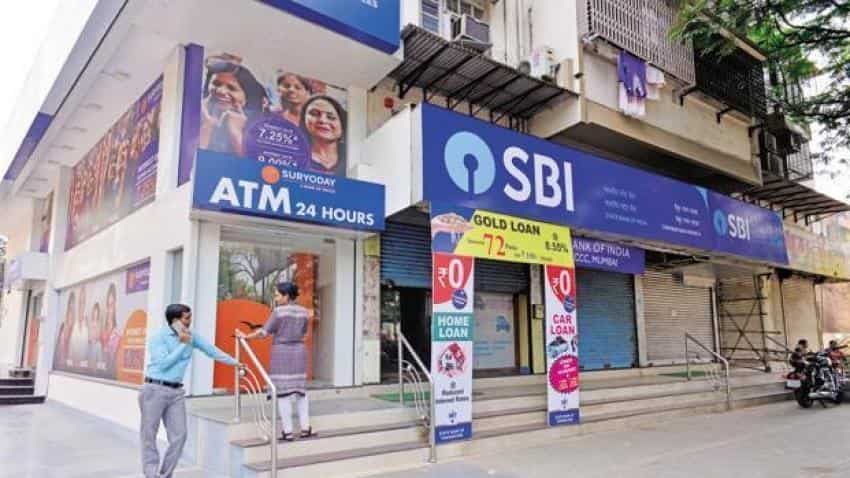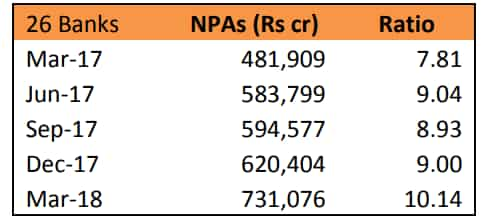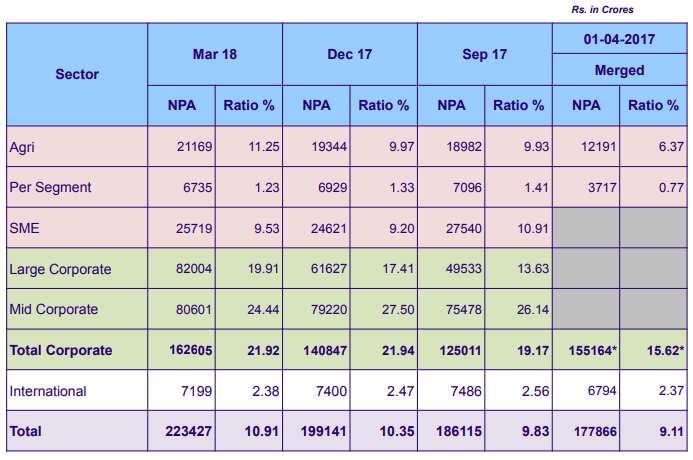SBI looks to slash NPA by Rs 40,000 crore; can it really overcome stressed assets crisis?
SBI's gross NPA surged by 98.88% to Rs 2,23,427.46 crore in Q4FY18 versus GNPA of Rs 1,12,342.99 crore of Q4FY17.

When we talk about State Bank of India (SBI), we believe nothing can go wrong with this lender, even though currently the entire banking system is choking with heavy stressed assets. The rise in NPA has been going on for years and the government along with the Reserve Bank of India (RBI) has not left a single stone unturned to tackle this issue as they continue to hamper earnings and credit growth of lenders. SBI is the current king in stressed assets compared to other banks, and things turned even bleaker when the bank merged five of it’s associate banks under its umbrella, as this led to a rise in NPA. However, SBI has buckled up and with the latest news being circulated, the bank is expected to recover about Rs 40,000 crore of this money. Well this can be said as baby steps for SBI, considering the huge chunk of stressed assets it has.
SBI’s Deputy Managing Director (Stressed Assets Resolution Group) Pallav Mohapatra in a Financial Express report said, “Our expectation is that we will be making a recovery of more than Rs 40,000 crore in the current financial year. We expect to get around Rs 25,000-30,000 crore from IBC (Insolvency and Bankruptcy Code) route and the balance would be recovered from other sources like sale to ARCs and one time settlement.”
The Deputy Managing Director highlighted some SBI data and it’s exposure to stressed assets. Under RBI’s first list of wilful defaults which included somewhat 12 companies, SBI had a massive Rs 48,000 crore exposure, whereas in the second list it has Rs 28,000 crore - which takes the total to Rs 76,000 crore worth cases before NCLT for bankruptcy.
Recently, Bhushan Steel, which was the highest defaulter in first list had undergone insolvency proceedings and was merged with Tata Steel. SBI got claim of around Rs 11,500 crore from Bhushan’s deal.
Apart from this, SBI has filed around 250 cases in National Company Law Tribunals (NCLT) which has exposure of a whopping Rs 95,000 crore.
So for now SBI is confident about recovering about Rs 40,000 crore, but it needs to be noted that the bank is still very far away in sorting out the NPA issue.
As on March 2018, gross NPA surged by 98.88% to Rs 2,23,427.46 crore in Q4FY18 versus GNPA of Rs 1,12,342.99 crore of Q4FY17. This was also up by 12.20% from GNPA of Rs 1,99,141.34 crore in Q3FY18.
In percentage terms, GNPA stood at 10.91% in Q4FY18 versus 6.90% in Q4FY17 and 10.35% in Q3FY18.
After when SBI announced it’s Q4FY18 financial performance, Care Ratings agency released a study report of 26 banks including both private and public banks (also having SBI) performance for the last quarter of FY18.

Under the Care Ratings report, 26 banks reported NPA of Rs 7,31,076 crore with a ratio of 10.14% as on March 2018, which was way higher than compared to NPA of Rs 4,81,909 crore with ratio of 10.18% as on March 2017. In one year’s time, these banks saw rise of Rs 2,49,167 crore in NPAs.
Guess what! SBI accounts for nearly 31% of the total NPAs recorded by the 21 banks in value terms. This is a rise from share of about 22.75% in total NPAs of all banks in the first quarter of FY18. Gross NPAs of SBI post merger, in percentage terms stood at 9.97% in Q1FY18 compared to 9.11% in Q4FY17 and 7.40% in Q1FY17.
Since then SBI has started posting losses in its financial book. As on March 2018, SBI posted a net loss of Rs 7,718.17 crore in Q4FY18 compared to net loss of Rs 3,442 crore in the corresponding period of previous year. Q4FY18 net loss widened compared loss of Rs 2,416.37 crore in the preceding quarter.
SBI’s gross NPA exposure is highest in mid and large corporates with Rs 80,601 crore and Rs 82,004 crore respectively in Q4FY18. This was followed by SME at third sport having exposure of Rs 25,719 crore and agriculture sector with Rs 21,169 crore in total NPAs.

Still SBI is seen as the strongest lender, which is why analysts are upbeat on this bank going ahead.
Darpin Shah, Pranav Gupta and Kaushik Utpat analysts at HDFC Securities said, “Despite the PBT loss, asset quality deterioration is actually better than feared. With a breakthrough in one NCLT case and a few more nearing finalization, SBIN can be one of the biggest beneficiaries.”
The trio added, “With stress from restructured pool completely recognized and increased visibility on NCLT resolutions, we expect asset quality to improve hereon. However, we factor higher slippages/LLP of 2.9/1.9% over FY19-20E. Resolutions in NCLT cases (Rs 776bn i.e. ~35% of GNPA) will further provide cushion to our earnings.”
Motilal Oswal said, “With significant cleansing of the book largely behind, we expect provisioning expenses to decline sharply, while gradual pick-up in loan growth/margins is expected to further boost earnings.”
Following this, analysts have maintained a buy call on SBI share price. Motilal said, “ We raise our FY19/20E earnings by 36%/12% and revise our PT to INR365 (1.5x FY20E ABV for bank). Maintain Buy.”
Nirmal Bang added, “We have revised our estimates for FY19/FY20 and retained Buy rating on SBI, revising our target price to Rs331 (from Rs364 earlier) and valuing the stock at 1.6x FY20E P/ABV and Rs65 for subsidiaries.”
Get Latest Business News, Stock Market Updates and Videos; Check your tax outgo through Income Tax Calculator and save money through our Personal Finance coverage. Check Business Breaking News Live on Zee Business Twitter and Facebook. Subscribe on YouTube.
RECOMMENDED STORIES

Small SIP, Big Impact: Rs 1,111 monthly SIP for 40 years, Rs 11,111 for 20 years or Rs 22,222 for 10 years, which do you think works best?

Power of Compounding: How long it will take to build Rs 5 crore corpus with Rs 5,000, Rs 10,000 and Rs 15,000 monthly investments?

SCSS vs FD: Which guaranteed return scheme will give you more quarterly income on Rs 20,00,000 investment?

Looking for short term investment ideas? Analysts suggest buying these 2 stocks for potential gain; check targets

SBI 444-day FD vs PNB 400-day FD: Here's what general and senior citizens will get in maturity on Rs 3.5 lakh and 7 lakh investments in special FDs?
07:18 PM IST









 Rama Mohan Rao Amara becomes SBI managing director
Rama Mohan Rao Amara becomes SBI managing director India's GDP expected to fall below 6.5% in FY25 amid slowdown in GDP growth in second quarter: SBI
India's GDP expected to fall below 6.5% in FY25 amid slowdown in GDP growth in second quarter: SBI SBI Funds Management Limited appoints Nand Kishore as Managing Director and Chief Executive Officer
SBI Funds Management Limited appoints Nand Kishore as Managing Director and Chief Executive Officer SBI to open 500 more branches in FY25, take overall network to 23,000: Finance Minister
SBI to open 500 more branches in FY25, take overall network to 23,000: Finance Minister Attention SBI Customers: EMIs of home loan, personal loan go up as PSU bank hikes lending rate
Attention SBI Customers: EMIs of home loan, personal loan go up as PSU bank hikes lending rate